© 2002
“Bet the person who skied that face soiled his shorts.”
Nils Larsen, telemark videographer, telemark instructor, telemark equipment consultant, and all around zealot of this subspecies of skiing, is standing beside me studying the face of Excelsior Mountain, a 12,446 foot peak near the northeastern border of Yosemite National Park and the tracks before us tell a story.
“He was waaay over his head.” Nils shakes his head, a sign I interpret to mean that this sinner defiled nature’s beautiful line with graceless skiing.
“You don’t approve of the way he skied this—of how he marred the slope?”
I know I’m setting myself up. Nils is an opinionated guy and because we share the same out-of-vogue views on most things, we fuel each other’s tirades.
“It’s not the individual tracks, that bother me,” he says, “It’s what those tracks say about the trend of skiing.”
Nils looks out over the scenery before us. Between the broad bowls, wide ridges and steep chutes, there are ski descents of all possibilities within our viewshed. “Look at all that terrain that someone who doesn’t know how to ski 40° slopes could have enjoyed,” he says pointing to a beautiful bowl a mile in the offing. “But this guy probably trudged in on fat skis and stiff plastic boots, and there was no way he was going to haul his load an extra mile to appropriate slopes. Nope, he’s another McGnarly wannabe.”
Nils and I, on the other hand, aren’t skiing the slopes of the Eastern Sierra specifically for the “gnar” like so many visitors who have left tracks near the Virginia Lakes trailhead where we started. We’ve come to enjoy Nordic skiing in all its forms—to skim across flat alpine meadows, climb gradual U-shaped valleys, glide up multiple peaks, scribe broad turns down moderate bowls and, maybe, to link tight turns down a few steep faces. We’ll ski a little “gnar” if conditions are right but rather than laboring up one peak for hours with the anchor of heavy gear just so we can shred the downhill in seconds, we’ve come to enjoy slopes of all angles.
Our skiing is a throwback to the roots of Nordic skiing—efficient cross-country travel interwoven with the poetic dance of turning–and our gear is, by the standards of the new millenium, a throwback too. We sport lightweight skis piloted by light leather boots. It’s a system made for covering ground and one that is not awfully different than what I skied in the late 1970s.
“This is typical of modern skiing,” says Nils still studying those unpoetic tracks. “The guy skied in here, skied that one line—poorly—and skied out.” He turns to me. “This is an example of what I’ve been telling you—nowadays skiers carry more but accomplish less.”
Like this skier, we too will ascend Excelsior Mountain, but that act constitutes merely a third of the day ahead. With our light gear, we will circumnavigate the entire massif forming the foundation of Excelsior Mountain. Combining many miles of touring with ski ascents/descents bucks the current trend so focused on steep skiing. By carrying less on both feet and back, however, we will not only enjoy mellow terrain but also hop on the steeps when snow conditions allow. With less we can accomplish more.
“You really are a Luddite.”
It’s evening and, contrary to the no-fire ethic of the era, Nils sits beside a little blaze enjoying the warmth. He is environmental in his environmental insensitivity. The few sticks of wood employed in his fire were collected half a mile away on the march to camp, the fire is built on top of a dinner-plate-sized rock and the ashes will be thoroughly scattered in the morning. To Nils, however, an evening under the stars isn’t camping without fire. But it’s not this tradition of fire that has me accusing him of Ludditism. It’s the fact that in this era of pile caps, plastic boots, synthetic gloves, and polyester socks he sits by the fire wearing a tweed driving cap while drying leather boots, deerskin gloves, and wool socks.
Ludditism is one of Nils’ favorite topics and he launches into a lesson. “People falsely believe that back in the early 1800s the Luddites revolted against all technology.” Nils explains that the Luddites protested the mechanization of the industrial revolution because the machines would put skilled weavers and craftsmen out of work and because the factories created such soulless work. “The Luddites rebelled against misapplied technology that didn’t improve the quality of life. And they were right about the evils of the new factories—they did put skilled laborers out of work, they did create inhuman working conditions.”
Given how passionate Nils is about skiing and the parallels he is drawing, there’s no way this conversation won’t turn to skiing. I hasten the inevitable. Looking at the low-tech gear he’s drying I ask, “So how do you decide from all our ski technology what is misapplied technology and what is worth adopting?”
“With my brain. Unfortunately, there’s way too much lemming behavior as skiers jump aboard new technologies and new trends established by marketers, magazines, and filmmakers. Skiers are told they should be skiing steep, so we go out and scare ourselves rather than go out and have fun. Skiers are told they need heavier skis to rip, so we go out and marry ourselves to gear that’s too heavy to accomplish much. Skiers are told synthetic rules, but I’ve yet to find synthetic gloves that are anywhere near as durable, economical, or functional as these deerskin ones. Pigskin gloves are even better.”
While hype has the tendency to lead skiers down questionable paths, Nils admits we have made technologic progress since the good old days, “Modern skis with no-wax bases… they can do amazing things—I’m not returning to wood. I use synthetic pants, shirts, and raingear.” He mentions Garmont’s new, very light, two-buckle plastic boot (the Excursion) “Those may lure me out of these,” he holds up his Karhu Nomads, the light leather telemarking boots we’re both using during this April tour. Considering he works for Karhu part of the year, that’s quite an admission.
“Like the Luddites, I’m not railing against technology per se, I’m railing against inappropriate technology—technology that rather than expanding our capabilities accomplishes nothing or, worse yet, diminishes our capabilities.”
In truth, the gear in our possession is extremely technologic. Our foam-core skis are shorter, wider, and shapelier than skis of old. They ski far better than the Europa 77s I started on decades ago, but like those skis of old they devour distance by remaining light under foot. Our 3-pin bindings are an aluminum alloy that can withstand tremendous torque yet, lacking a cable, allow unrestricted heel—“Free the heel and you’re free of blisters.”
Then there’s the very considerable technology wrapped up in what we carry—or, rather, in what we don’t carry. A Nilsian axiom maintains, “If you ski on light gear you ski with a light pack.” It’s all a matter of balance — you need good balance to ski light gear and heavy packs undermine balance. Furthermore if you intend to cover distance, feathery boards on the feet accomplish little if you strap an anchor to the shoulders.Consequently we carry not only the provisions for five days of skiing but also everything needed to safely weather the backcountry in packs weighing 29 pounds. To say our LED headlamps, Silicone-nylon tent, polycarbonate shovels, electronic transceivers, and Spectra-cloth packs are a rejection of technology would be a joke. Instead they are appropriate technology for the goal of accomplishing more with less. Left on the shelves of the stores are the inappropriate technologies advertisers try to pedal but which make us the mules of our load: seven-pound packs, six-pound tents, four-pound sleeping bags, 3½-pound storm suits, camp chairs, cappuccino makers, candle lanterns…
The sky has purpled down to black and stars arch across its screen. We lay back and appreciate a sky so black it’s nearly white with stars. It’s good to be here enjoying Muir’s Range of Light at night. We are hours beyond the last tracks laid by others yet our light gear has made short work of reaching this timberline camp.
…story continues on page 2…
© 2002

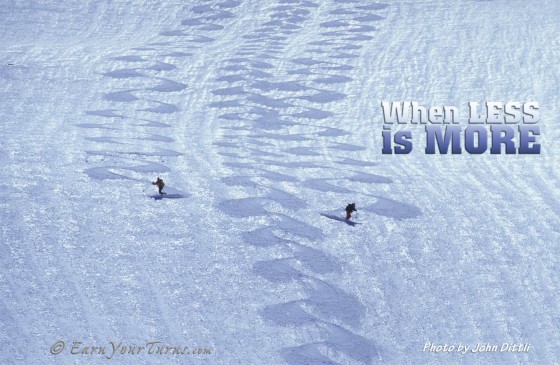
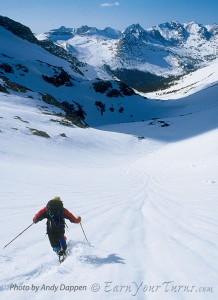
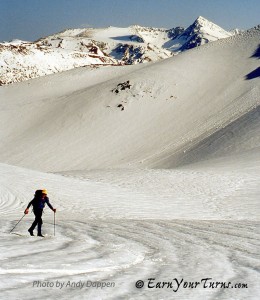
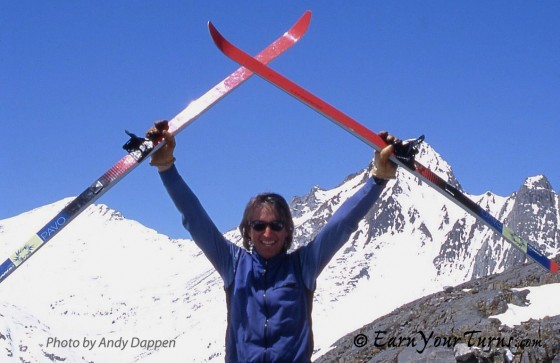
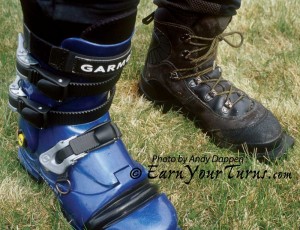
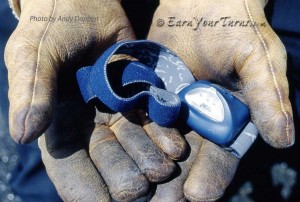
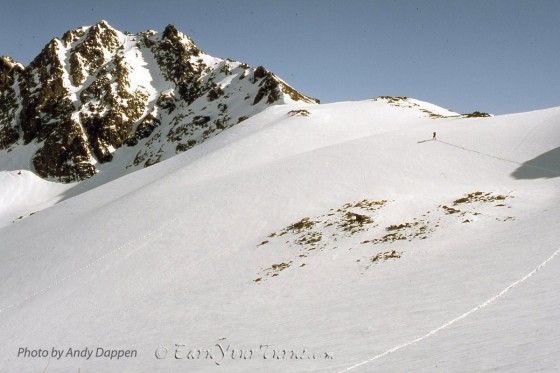
3 comments
Great rerun article, thanks for putting it up, made for a good morning read.
options are always good. Touring with Nils is always an mind/body experience. One of my favorite runs of my life are skiing down prospector B chute in deeper than knee deep untracked powder at Whitewater Ski Resort in a pair of NNNBC boots with one buckle/strap and a pair of old light downhill skis and my partner in AT gear falling in front of me as I hooted and shredded past. With that gear on you could actually run up the skin track. That being said if there was even the slightest bit of tracked up snow, or crappy conditions you were screwed. But I don’t want to ski that stuff anyway. Haha
What a narcissist I am. Enjoyed reading this old story. I do most of my skiing on AT gear these days. My boots (Scarpa Aliens), ATK pin-tech race bindings, and Hagan Y-Drive skis give so much more power and flotation for virtually the same weight as the Karhu Pavos I skied with Nils. Amazing! Where I lose out for spring corn tours is the no-wax base… of course no-wax option exist.